A Guide on How to Travel to Xinjiang
China Off the Beaten Path || Discover Xinjiang

These are the locations you’ve probably heard of when you started planning your travels around China. Don’t get me wrong. These places have delicious food, thousands of years of history, and are definitely worth going to.
But these are places all tourists travel to, both domestic and international.
And sometimes weaving your way through the massive crowds, especially during official Chinese holidays, doesn’t sound like a relaxing vacation.
If you’re looking to explore the less-known parts of China (China off the beaten path), let this four-part series be your guide.
First, let’s buckle our seat-belts and head to China’s most northwestern region, Xinjiang (新疆, Xīnjiāng).
Discover Xinjiang || Introduction
Discover Xinjiang || What to See
Discover Xinjiang || What to Eat
Discover Xinjiang || How long to Spend in Xinjiang
Discover Xinjiang || Suggested Destinations
Brief Introduction to Xinjiang
Most people don’t realize that China is a very diverse place, a home to 56 officially recognized ethnic groups (and many more unofficial ones).
Xinjiang is representative of that, with at least 13 different ethnic minorities (少数民族, shǎoshùmínzú) calling it their home.
Many of the ethnic groups found in Xinjiang also can be found in countries around Central Asia, including Uighurs, Kazakhs, Kyrgyz, Tajiks, and even Russians. Many are Muslim, and speak Turkic languages.
| English | Chinese (with pinyin) | Short Version (in Chinese) |
|---|---|---|
| Uighur | 维吾尔族, wéiwúěrzú | 维族 |
| Kazakh | 哈萨克族, hāsàkèzú | 哈族 |
| Kyrgyz | 柯尔克孜族, kē’ěrkèzī | 柯族 |
| Tajik | 塔吉克族, tǎjíkèzú | 塔族 |
In Xinjiang, you will feel like you’ve left the China you’re familiar with.
Travel to Xinjiang || What to See
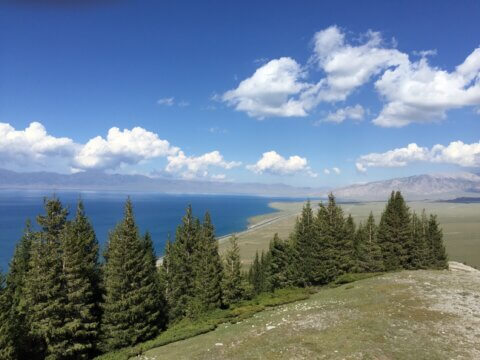
In addition to being ethnically diverse, Xinjiang is also very geographically diverse.
In Xinjiang, you’ll found glistening mountain lakes, rolling grasslands, towering glaciers, and seemingly endless deserts. China’s hottest place, Turpan (吐鲁番, tǔlŭfān), is also located in Xinjiang.
For other ideas, visit our Best Places To Visit In China … For Scenery
If you’re a lover of the outdoors, you’ll find the adventure you’re looking for, whether its cycling the high-altitude Karakoram Highway (喀喇昆仑公路, Kālǎkūnlún Gōnglù) or star-gazing while camping out on the Taklamakan Desert (塔克拉玛干沙漠, Tǎkèlāmǎgān Shāmò).
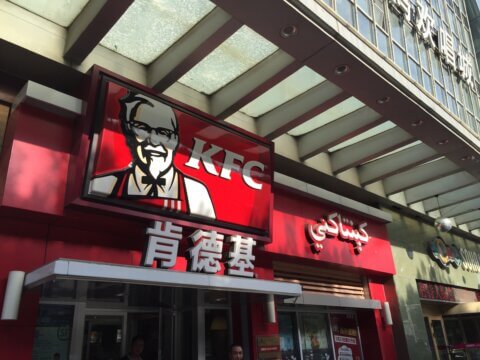
If you’re only looking to dip your toes in adventure, you can ride horses in the grasslands surrounding Sayram Lake (赛里木湖, sàilǐmùhú) near the border with Kazakstan.
Or you can adventure with your palate by taking in the smells and sights of Central Asian cuisine at the night market in Kashgar (喀什, Kāshí).
FUN FACT:
You may have noticed that names of places in Xinjiang don’t look or sound like Mandarin.
That’s because many of the places in Xinjiang take their name from the local languages (usually Uighur, which is a Turkic language, spoken by Uighurs, the most populous ethnic minority in Xinjiang).
Although, Mandarin is always an asset while traveling anywhere in China; there are many people who you may encounter here that won’t speak much Mandarin. Why not use this opportunity to learn a few words in Uighur?
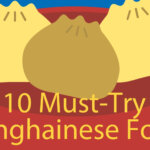
10 Must Try Shanghainese Foods 🍜 Your Complete Guide
Chinese food is so diverse that it’s really difficult to say what’s best, so we’ve diluted it down. Here are the top 10 best Shanghainese food dishes.
Travel to Xinjiang || What to Eat
As many people in Xinjiang are Muslim and do not eat pork, you’ll find that lamb here is everywhere. Get ready for the freshest (literally cut right off the animal) lamb you’ve had in your life.
Langman
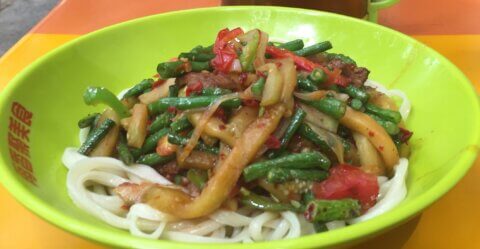
If the few words you learn in Uighur turn out to be food, you’re in for a treat!
The quintessential dish here is langman (拌面, bànmiàn).
This dish is hand-pulled noodles topped with stir-fried veggies and some bits of delicious lamb meat.
Pair with this a delicious 串 (chuàn, skewer) of lamb with a drop of tea, and you’re good to go for one of the simplest and most delicious meals you’ll ever have.
Samsa
Most visitors to China have heard of the dumplings 包子 (bāozi, pork buns) and other types, but have you heard of 烤包子 (kǎobāozi, samsa)?
Samsa are lamb-filled buns cooked in a tandoori oven (kind of like a clay, vase-shaped oven).
They are smoky, juicy, and make the perfect breakfast food or snack.
Pollo
Another Central Asian classic, pollo (手抓饭, shǒuzhuāfàn), will get you your rice-fix.
As the Mandarin name suggests, this rice pilaf is traditionally eaten with with your hands, but you can certainly use chopsticks or a spoon.
Naan
Naan (馕, náng) is not just a staple of cuisine of Indian cuisine, but also of Xinjiang cuisine. This freshly-baked bread is a great snack or a perfect complement to the juicy and fatty lamb skewers.
For fans of fresh, cheap fruit, Xinjiang is the place to be – imagine the freshest, juiciest watermelon, grapes, and cantaloupe you’ve ever had. In Xinjiang, it’s even better. And you’ll need the refreshment; temperatures can get up to 45 degrees (110° F) in some places.
How Long to Spend in Xinjiang?
Xinjiang is China’s largest region. Travellers usually split it into two areas: Northern & Southern Xinjiang (北疆/南疆, běijiāng/nánjiāng).
Since Xinjiang is one of China’s less developed regions, don’t expect to find the number of high-speed trains you’ll find on the East Coast. Instead, you’ll have to take lots of slow trains (some overnight), buses, and shared taxis.
NOTE: There is always the option of flying, but it can get expensive.
For this reason, I recommend going for at the least 2 weeks (depending on whether or not you want to do just part of Xinjiang, or all of it).
For a more leisurely pace, I would suggest one month.
Suggested Route
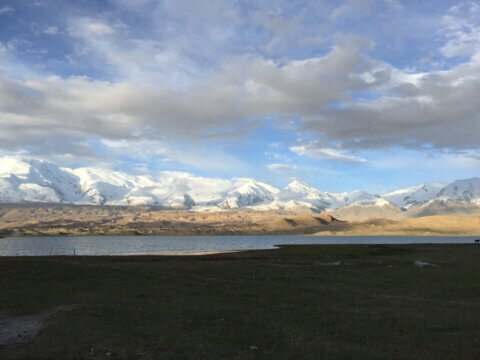
Here are some top places I would recommend you visit if you travel to Xinjiang.
Flights to Urumqi (乌鲁木齐, Wūlǔmùqí) the capital of region can be pricey, consider flying to Lanzhou and taking the train in.
- Turpan – the hottest city in China, features some truly fantastic ruins and caves of ancient civilizations.
- Urumqi – capital of the region.
- Altay (阿勒泰, Ālètài) – beautiful lakes and grasslands.
- Yining (伊宁, Yīníng), Sayram Lake, Nalati Grasslands (那拉提草原,Nàlātí Cǎoyuán) – closer alternative to Altay (which is not very convenient to get to), features beautiful grasslands and lake areas, home to China’s Kazakh ethnic group.
- Kashgar – home to the famous Kashgar night and China’s biggest mosque.
- Karakoram Highway – Karakul Lake, Tashkorgan (塔县, home to China’s Tajik ethnic group).
在新疆见! See you soon in Xinjiang!

Chinese Food Therapy 食疗 shí liáo // A Beginner’s Guide
What is Chinese Food Therapy? There are many things to love about living in China, and one of them is of course, the food (see below)! There seem to be an unlimited amount of food options in China. Shanghai alone…
Xinjiang || FAQ’s
What is Xinjiang in Chinese?
Xinjiang is written as 新疆.
Is Xinjiang big?
Xinjiang is in fact the biggest province in the entire country of China at over 1,500,000 square kilometres. Crazy right!
Are there many ethnic groups in Xinjiang?
Most people don’t realize that China is a very diverse place, a home to 56 officially recognized ethnic groups (and many more unofficial ones).
Xinjiang is representative of that, with at least 13 different ethnic minorities (少数民族, shǎoshùmínzú) calling it their home.

 Hi, my name is Mojca. I am from Slovenia in Europe and I and I work as a student advisor at our Shanghai school.
Hi, my name is Mojca. I am from Slovenia in Europe and I and I work as a student advisor at our Shanghai school.



3 comments
Do you have in the german language also?
We have a German website based at https://ltl-chinesisch.de Emil 🙂
This blog is not currently in German but we have plenty of other content on the blog there.
Enjoy reading!
where can a man from the USA go to search for a beautifull Chinese wife? Do I search in a big city or search the smaller towns? maybe pass my name and email to friends looking to marry an american.